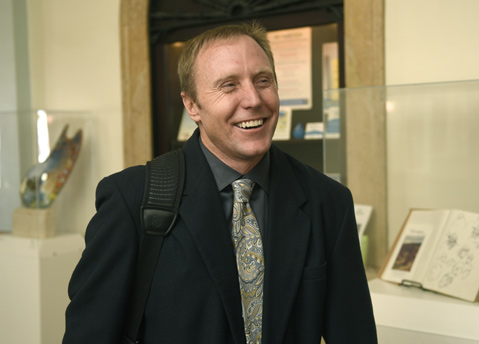Council Pulls $55 Million Trigger to Restart Desal Plant
Also Sends Rental Project Back to the Drawing Boards

Just two days after Santa Barbara experienced the collective cognitive dissonance inflicted by thunder, lighting, and an of inch of rain in the middle of July, the Santa Barbara City Council voted unanimously to pull the $55 million trigger to revamp and reactivate its long mothballed desalination plant.
Most councilmembers acknowledged the strong possibility that the El Niño storm systems predicted for this winter could likely bring heaving rains. But given that the South Coast’s single most important source of water — Cachuma Lake — is so low that further deliveries are expected to cease this year, not one councilmember was willing to take that risk.
With or without rain, declared Mayor Helene Schneider, desalinated water will have to become part of the city’s supply portfolio. “This drought will end one day,” she said. “But there will be another drought another day.” Councilmember Gregg Hart estimated that the cost of desalinated water would translate to a $10- to $20-a-month increase in the average customer’s water bill. “That’s not a lot of money in the context of the risk involved,” he said.
Councilmember Bendy White, the council’s resident water wonk, noted how even in wet years, the future flow of water from Cachuma Lake will be substantially reduced as tighter environmental regulations go into effect. Without desal, he warned, the city would be forced to strip mine its groundwater reserves, running the risk of saltwater intrusion. Councilmember Randy Rowse groused, “It’s not a great choice. I’d rather not do a desal plant,” adding, “There’s a lot of things I’d like to do I just don’t get to do.”
Of all the water options facing Santa Barbara, said Councilmember Dale Francisco, desal is the “only one we control.” Even Councilmember Cathy Murillo — the most torn by environmental concerns about small fish and aquatic larvae getting sucked into the intake pumps — argued the council had no choice. Santa Barbara Channelkeeper’s Kira Redmond, who has consistently banged the gong about those concerns, termed the vote “a $55 million mistake.” She pointed out how it’s rained almost every time the council confronted a major desal decision point. “I wonder if that’s Mother Nature telling us to stop,” she said.
City water czar Joshua Haggmark beamed after the vote. “This drought is 20 inches drier than the last major drought,” he added. “What I wouldn’t give to have an extra 20 inches,” he said. “That’s a year’s worth of rain.” By comparison, the desal plant — if all goes according to plan — will go online next September, producing 3,125 acre-feet of water a year. That’s about 25 percent of the city’s water demand in an average year.
The council voted to sign a contract with IDE Technologies, an American subsidiary of an Israeli company that’s been involved in building or operating 400 plants in 40 countries that produce a combined 400 million gallons a day. The same company is building the much bigger Carlsbad desal plant.
In a separate action, the council praised a seven-unit, three-story rental housing project targeting families and slated for the 1800 block of Castillo Street, but concluded it was too much of a good thing and sent it to the Planning Commission for tweaking. In so doing, the council sided with the neighbors — led by former councilmember Brian Barnwell — who’d appealed the project’s approval by the Architectural Board of Review (ABR). It was one of the rare instances the council affirmed a neighborhood appeal.
In this case, the developer — represented by architect Detlev Peikert — sought to avail themselves to an experimental city zoning initiative to encourage the construction of rental housing by rewarding builders with extra-high densities. The extra density is achieved by allowing developers to provide only half as many parking spaces as usual. In this case, that translated to 19 bedrooms but only seven parking spaces.
Barnwell argued that the garage spaces abutting the units would quickly be converted into rental space, thus exacerbating an acute shortage of on-street parking in the neighborhood. Many neighbors complained the three-story proposal was out of sync with the area. Barnwell objected the ABR never required story poles to show how tall the project would be and that the ABR never conducted a site visit. (City planners stated ABR members had either visited the site or had expressed familiarity with it.)
Councilmembers took pains to praise the owners and Peikert for proposing rental housing; they lauded the design. But with the exception of Cathy Murillo, who cited Santa Barbara’s “brutal” rental market, all councilmembers agreed the project was just too big for the neighborhood and sent it to the planning commission to be whittled down.



